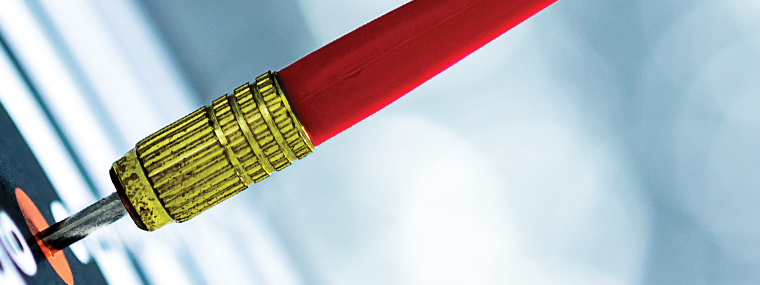
Chapter Three, Part One: Advertising
Creating the Right Impression
By Beth Borrego / Published April 2020

Ads come in different shapes, sizes, and formats, but they all share the same end goal, which is to sell a product, a service, or a brand. There are many places you’ll find ads. Even today, print ads are an effective means for small businesses to reach their target market. Now, I know that you’re thinking that you really don’t need to know how an ad is put together because you don’t plan on creating your own ads. However, as a business owner, you should be able to proofread any documents that another firm produces on your company’s behalf and at a glance tell if the content is properly put together or not and if it accurately represents your company’s image and its services. Each time a potential customer views an ad, it’s an impression. It normally takes about six impressions for consumers to remember your company, so you want them to be on point and to deliver the right message. Regardless of whether the ad is served in print or digitally, it must be consistent across all platforms and easily identified as your brand.
Before we get into the structure of the ad, let’s take a look at some of the types of print ads. Keep in mind that some ads are more effective in certain demographic areas than others are, but it’s still good to be aware of them. One very important note: if your competition uses a specific advertising method and has for years, it probably works well. The road more traveled is a safer investment than the one you never see used. Let’s review the types of ads that are most common.
Business Card
Does this surprise you? Your business card is a small, mobile ad. It should go everywhere you go, and you should hand them out enthusiastically to anyone you talk to about your business. Long ago, everyone printed on one side of the card, and usually the print was in one color. Don’t waste the other side by leaving it blank! Consider a full-color card, with small before and after shots on the back side. The front side will still contain your up-to-date contact information, such as your company name, personal name, title, phone, email address, website, and some of your services.
Here’s a business card tip for you. Take a photo of your business card with your phone, both sides if it is a two-sided card. The next time you have an opportunity to hand out a card, look for a card in your pocket but do not come up with one right away. Instead, ask the person’s name, email address, and phone number and send the digital copy while the person is standing next to you. You now have a contact. Next you can find your card in your other pocket to hand out. You have gone above and beyond to get the person your info, and you also have the prospect’s information. The prospect has both print and digital copies of your contact information, and most importantly you have a way to reach out to him or her.
Phone Book Ad
Today the phone book is not used nearly as much as it once was. You can find it all online, via YellowPages.com. There are still some folks who only use print media, but these folks are far fewer these days, so it is prudent to look online for directory advertising. These online directories may yield better results.
Print Media Mailer Ads
There are many print media mailer products that for our purposes here fall into what I will call the print media mailer ads. Coupon envelope mailers, such as ValPak or Money Mailer, and magazine-type books, such as Clipper Magazine or Ad-Vantage, fall into this category, and now have an online presence as well. Typically, these ads are attractive to consumers who use coupons. Not all of the consumers who read them clip the coupons, so don’t let that turn you off to the idea of using them. All of them suggest that a coupon be placed in the ad at the bottom or on the side to make it easy for consumers to clip coupons. Direct mail companies market their product usage rate to their customers who advertise with them by offering themselves as a savings vehicle. For the most part, the advertisers using these mailers will place a coupon in the ad. These ads mail in large numbers, typically to one or more zip codes and to tens of thousands of homes. These advertisers know that online ads are incredibly important, and they typically offer an online presence to their advertisers, placing the ad, coupon, or contact information online so that the advertiser print and digital ads release together and complement one another.
Postcards
These are popular and easy to mail to specific targeted markets to promote a specific service. They are low cost and unlike the print media mailer, you can control how many post cards to mail at once. You can mail to as few or as many as you like. If you purchase a mailing list and mail the postcards yourself, you can better regulate the influx of inquiries. However, don’t mail to too few prospects. Think thousands, not hundreds, when you prepare a campaign. If you don’t have the time or the office staff to handle a postcard mailer yourself, there are companies online like Postcardmania.com that will do it all for you.
Letters
You might want to mail letters of introduction, follow up, or news of new offerings from your company, especially if you are selling to commercial customers. The letters should be carefully written and crafted to address the needs of the customer you are courting. If you are introducing your company and your services to property managers, make certain that the services you mention are the ones they are most likely to purchase for the properties that they manage. For those selling to residential customers, a welcome to the neighborhood letter to new homeowners could also be appropriate. In either case, don’t forget to enclose your business card. Letters are good for more focused mailers, and are well suited to telephone follow-up calls so that you can reiterate the content of the letter and introduce your company more personally.
Billboards
These ads are large and give you an abundant amount of space to create a visually appealing ad that will attract consumers of all types. Over time, consumers who see these signs during their daily commute will get to know your company. It’s a great way to get top-of-mind recognition quickly, but it can add up.
Flyers and Door Knob Hangers
These two kinds of ads are very basic. Flyers are typically comprised of text and are printed on colored paper. They are often left on the mailbox or rolled up in a door handle or under a windshield wiper. Many consumers find plain flyers to be distasteful. However, doorknob hangers are the wealthy cousin to the flyer and can be printed on a thicker card stock in full color on both sides. A hole is punched in the card at the top so that it can easily be hung from a door knob. Either can be handed out in an area where you are trying to get work, or to the surrounding houses where you are currently working. If done correctly, it is possible to design a doorknob hanger to resemble your company post cards, which will make them not only visually appealing but create another familiar impression. Never place either inside the mailbox. It’s a federal offense, and you can get fined for it.
Yard Signs
These are inexpensive and should be placed in front of the area you are working on while you are there. A word of caution: placing these signs in common areas owned by the state or county may result in fines. Be careful to place the signs only where you have permission to do so. If a customer objects to the use of a sign on their property, don’t place the sign. It is far better to be remembered by the customer as being a company that respected their wishes than one that did not. After all, when a customer speaks to friends, family, and neighbors, you want them telling positive stories, not negative ones.
Truck Signs
There is nothing quite as rewarding as when a customer exclaims, “I’ve seen your trucks all over town.” Equally gratifying is seeing someone write the phone number down at a stop light. Your trucks should have either permanent lettering or magnets. Blank trucks have no story to tell, and they don’t create an impression in the mind of the consumer that gets you closer to having top-of-mind recognition. It’s just that simple.
Editor’s Note: Part Two will appear next month and continue to review the more common types of ads.





